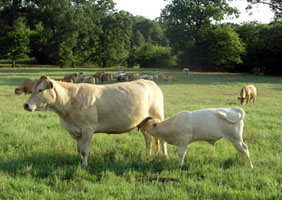
As someone who lives in Santa Fe, New Mexico at 7,000 feet elevation this is of more than casual interest.
by Mark Holm for the New York Times.
JEMEZ SPRINGS, N.M. — For tourists traveling into the mountains, altitude sickness can be an uncomfortable reality. The lightheadedness. The nausea. The vicious headaches.
Catheters are inserted in the animals to measure blood pressure and how well they adjust to thin air at high elevations.
Cattle, ostensibly, endure a similar fate. Each year, ranchers who raise their herds on the lush grasslands of the Rockies find that up to 20 percent can suffer from a form of high-altitude sickness, commonly known as brisket disease.
The illness, brought on by a lack of oxygen, which causes the restricting of blood flow in small arteries in the lungs, is particularly costly for ranchers. Experts who have studied the condition estimate that it kills more than 20,000 cattle across the West each year and renders many more unproductive.
For the three years now, as part of a continuing effort to contain the illness, a team of researchers from New Mexico State and Colorado State Universities have been trying to determine which cattle are more likely to be genetically disposed to survive at high altitudes, where grazing can be plentiful.
On Monday, the team spent hours at the sprawling Valles Caldera National Preserve in northern New Mexico, performing pulmonary arterial pressure measurements on young cows and bulls. The measurements involve gauging the blood pressure on the right side of an animal’s heart, which indicates how well cattle will adjust to the thinner air found at higher elevations.
“We started realizing many years ago what the altitude was doing,” said Dr. Tim Holt, a veterinarian with Colorado State, as he slithered a catheter into a bull’s jugular vein and toward its heart to get a reading.
“We also know there are other agents involved, too, which are difficult to control,” Dr. Holt said.
Though the test has been around for years, and more cattle ranchers have been using it on their own, researchers like Dr. Holt are also examining whether factors like drought, nutrition and genetic markers can identify the most vulnerable animals.
At 8,600 feet above sea level, Valles Caldera, tucked among the Jemez Mountains, is believed to be one of the nation’s highest testing facilities for the condition, making it an especially accurate meter.
Indeed, brisket disease is especially prevalent in the Rocky Mountains, where cattle from the region are taken to graze on nutrient-rich, high country grass and roam among pastures leased inexpensively from the Bureau of Land Management.
From May to November, there are typically more than a million cattle scattered across the Rocky Mountain region, said Manny Encinias, a beef cattle researcher at New Mexico State who is also working on the project.
But much like humans, cattle that are rapidly transported to altitudes greater than 5,000 feet, are vulnerable to health problems. The shortage of oxygen causes a bull or cow’s lungs to constrict and can cause fluids to leak from the bloodstream into the brisket or chest area. Sick animals can lose weight or die if they are not taken to lower elevations.
“One year, everything can be fine for a rancher, and the next year, you can be in a major wreck,” Dr. Encinias said. “Guys come up here from the lower altitudes and they don’t always understand how vulnerable the altitude can make their cattle.”
For local ranchers, whose livelihood depends on whether they can sell a healthy animal, the prospect of knowing which cattle will fare better can be the line between profit and hard times.
“It’s something my family has been dealing with for four generations,” said T.J. Smith, a southern Colorado rancher who paid $200 to $300 a head so his ranch’s yearlings could participate in the research project, which includes four months of grazing at Valles Caldera.
Mr. Smith said his family had already been using the test. But he was interested in the researchers’ efforts to identify cattle that were genetically suited to fight off the disease.
One rancher, Bill Gardner of Estancia, watched intently as Dr. Holt jabbed one of his bulls with a needle. This was the first time Mr. Gardner had brought his bulls to the facility, and up until now he had been pleasantly surprised at how well they had tested. This bull, though, scored a 57, which meant he was not adjusting to the altitude and would probably get sick.
“We’ll take him down to lower elevations,” Mr. Gardner said. “Bulls like him will be fine for ranchers down there.”
